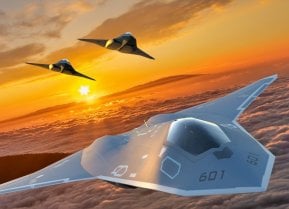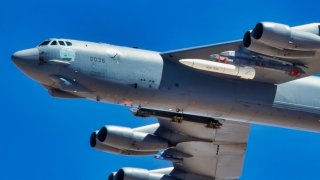U.S. Air Force Conducted Final Hypersonic ARRW Test in the Pacific
The U.S. Air Force recently conducted a test of the AGM-183 Air-Launched Rapid Response Weapon (ARRW) at the Reagan Test Site on Kwajalein Atoll in the Pacific Ocean. A B-52 Stratofortress taking off from Andersen Air Force Base, Guam, carried out the all-up round test.
The U.S. Air Force on Sunday conducted a test of the AGM-183 Air-Launched Rapid Response Weapon (ARRW) at the Reagan Test Site on Kwajalein Atoll in the Pacific Ocean. A B-52 Stratofortress taking off from Andersen Air Force Base, Guam, carried out the all-up round test.
Though the Air Force called the test a success, it did not disclose the speed at which the weapon flew.
"This test acquired valuable, unique data and was intended to further a range of hypersonic programs," an Air Force spokesperson told Defense News. "We also validated and improved our test and evaluation capabilities for continued development of advanced hypersonic systems."
The ARRW is one of the service's two main programs to develop a hypersonic air-to-ground missile. It is equipped with a rocket motor that can speed it past Mach 5 before the missile glides to its target. It is seen as a potential game-changer for the Air Force. By traveling at five times the speed of sound, the weapon gives combatant commanders the ability to hit time-sensitive targets with ease.
The weapon was employed from the B-52 throughout testing, but it was developed to be carried by a variety of aircraft, including the B-1B Lancer supersonic bomber, B-21 Raider, and possibly the F-15E Strike Eagle.
ARRW: Hits and Misses
During a May 2022 test flight, a B-52H Stratofortress successfully released the ARRW off the Southern California coast. Following separation from the aircraft, the ARRW's booster ignited and burned for the expected duration, achieving hypersonic speeds five times greater than the speed of sound.
The ARRW previously suffered through several testing failures, including a July 2021 rocket motor failure, followed by a flight test failure in December of that same year. As a result, last March, Congress halved funding for the hypersonic platform. This seemed to signify the program’s impending end.
But as Alex Hollings reported, recent tests show the ARRW has a path to service after all.
Hollings also suggested that limited testing opportunities were an issue with the ARRW. Given the speed and range of the weapons, there are only so many places where the ARRW and similar platforms can be adequately tested.
"The most significant issue facing the ARRW program to date… is a lack of adequate testing facilities within the United States, forcing all of America's 70+ hypersonic weapon and aircraft programs currently in development to compete for very limited range time," Hollings wrote. "ARRW testing, for instance, has largely been conducted over open ocean that provides the ranges required for missile flight testing, but minimizes the data that can be gathered about terminal flight characteristics or even accuracy."
Full Speed Ahead for Hypersonic Weapons
Despite the setbacks the ARRW program experienced, the Air Force remains committed to developing a hypersonic weapon. According to its latest budget request, the service is focused on the scramjet-powered Hypersonic Attack Cruise Missile (HACM), which in the coming years could become the first weapon of its kind to enter any military’s service.
The HACM could offer several advantages. The ARRW's size requires that it be launched from a bomber, while the HACM will be small enough for a fighter-sized aircraft to carry. The air-breathing scramjet engine would also give it a longer range than the ARRW.
The HACM’s superior traits could suggest the ARRW has reached the end of the line, but the recent tests might prove otherwise. Both Russia and China have charged ahead in the development of hypersonic weapons, and the United States is now forced to play catch-up with little time to spare. Starting from scratch may not be an option.
Author Experience and Expertise: Peter Suciu
Peter Suciu is a Michigan-based writer. He has contributed to more than four dozen magazines, newspapers, and websites with over 3,200 published pieces over a twenty-year career in journalism. He regularly writes about military hardware, firearms history, cybersecurity, politics, and international affairs. Peter is also a Contributing Writer for Forbes and Clearance Jobs. You can follow him on Twitter: @PeterSuciu. You can email the author: [email protected].


